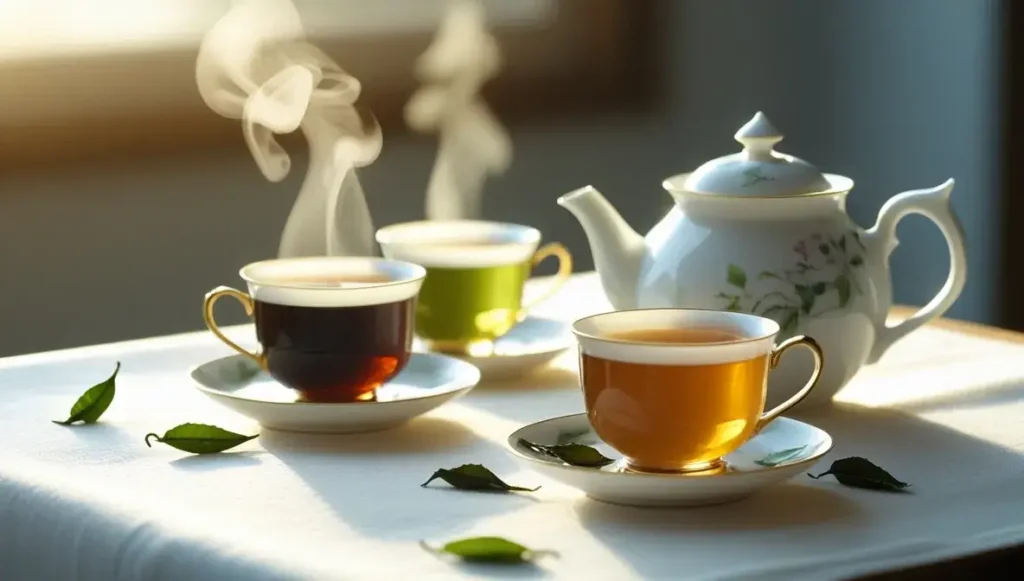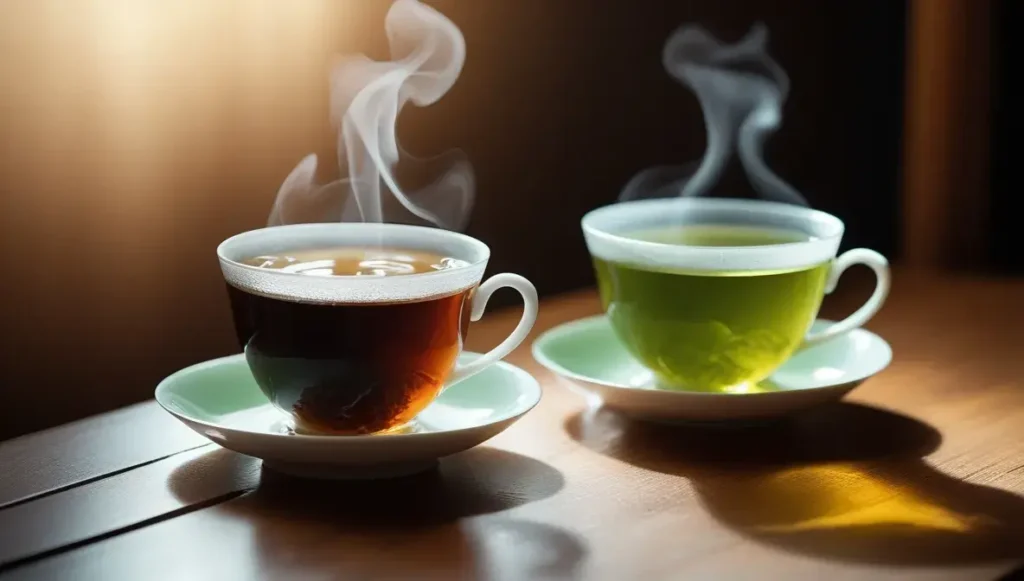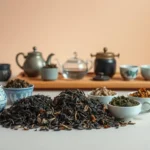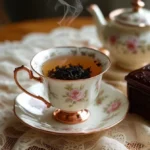Table of Contents
Ever find yourself staring at the tea aisle, wondering which cuppa will give you that much-needed energy boost? It’s a common question: black tea or green tea more caffeine? While they both come from the same plant, the way they’re made really changes things up. Let’s break down what’s really going on inside your mug.
Key Takeaways
- Generally, black tea has more caffeine than green tea because of how it’s processed.
- The oxidation process that black tea goes through makes its caffeine easier to pull out when you brew it.
- Factors like the type of tea, how long you steep it, and the water temperature can change the caffeine level.
- Matcha, a type of green tea, can actually have more caffeine than many black teas.
- Both teas offer health benefits, but green tea often has more of certain antioxidants (like EGCG) while black tea has others (like theaflavins).
Understanding Caffeine Differences Between Black Tea and Green Tea

When you’re reaching for a cup of tea, whether it’s a robust black tea or a delicate green tea, you might be wondering about the caffeine kick you’ll get. It’s a common question, and the answer isn’t always as simple as you’d think. Both black tea and green tea come from the same plant, Camellia sinensis, but the way they’re processed makes a big difference in their final caffeine content. So, does black tea have more caffeine than green tea? Generally, yes, but there’s more to the story.
General Caffeine Content Comparison
Let’s get down to the numbers. On average, an 8-ounce cup of black tea typically contains between 40 and 70 milligrams (mg) of caffeine. This makes it a solid choice for a morning boost or to help you power through that afternoon slump. In contrast, a similar-sized cup of green tea usually has a bit less, ranging from 20 to 45 mg of caffeine.
This lower amount makes green tea a good option if you’re sensitive to caffeine or prefer a gentler lift. It’s interesting to see the tea caffeine comparison, as even the higher end of green tea caffeine is often less than the lower end of black tea caffeine. This difference is a key point when comparing caffeine in tea types.
Factors Influencing Caffeine Levels
But hold on, it’s not just about whether it’s black or green. Several things can tweak these numbers. The specific variety of the tea plant matters, as do the growing conditions like climate. Even the size of the tea leaves plays a role; younger buds and smaller leaves often pack more caffeine. And then there’s how the tea is presented – tea bags, which often contain smaller, broken leaves, can release caffeine more quickly than whole loose leaves. So, while we talk about averages, your actual caffeine content can vary quite a bit.
The Role of Processing in Caffeine Extraction
The biggest player in the caffeine difference between black tea vs green tea caffeine levels is processing. Green tea leaves are quickly heated after picking, usually by steaming or pan-firing. This stops oxidation, preserving the green color and delicate flavor. Black tea, on the other hand, is fully oxidized. This process changes the chemical makeup of the leaves, making the caffeine more accessible when you brew your tea.
Think of it like this: the oxidation in black tea makes the caffeine easier to pull out into the water during steeping. This is a fundamental reason why you’ll often find higher caffeine levels in black tea versus green tea. It’s a fascinating aspect of tea caffeine comparison that highlights how a plant can yield such different results based on human intervention.
The journey from a fresh tea leaf to your cup involves more than just drying and rolling. The specific steps taken to process the leaves, particularly the level of oxidation, directly influence how much caffeine ends up in your brew. This is why understanding the processing is key to understanding the caffeine content black tea vs green tea.
Here’s a quick look at how processing affects caffeine:
- Green Tea: Minimal oxidation. Caffeine is less readily extracted.
- Black Tea: Full oxidation. Caffeine is more easily extracted.
This core difference in processing is why, for the most part, black tea caffeine versus green tea will show black tea having a higher amount. It’s a simple yet significant distinction that impacts your daily tea ritual. If you’re looking for a reliable energy source, black tea often fits the bill, but green tea offers its own unique benefits with a gentler caffeine presence.
👉 Try the Proven Superior Black Tea for Maximum Energy 👈
Caffeine Content: A Closer Look at Black Tea

Average Caffeine Range in Black Tea
Black tea sits at the top when it comes to the caffeine content tea comparison between common tea types. An average 8-ounce cup of black tea usually has between 40 and 70 mg of caffeine. But the actual number can move a bit, depending on brewing style, leaf cut, and even whether you’re using a bag or loose leaf. Here’s a quick look at how caffeine in popular teas stacks up:
| Tea Type | Average Caffeine (mg per 8 oz) | Notes |
|---|---|---|
| Black Tea | 40–70 | Robust, bold flavor |
| Green Tea | 20–45 | Lighter, gentle alertness |
| Coffee | 95–165 | Much stronger stimulant |
This handy comparison lets you get a quick feel for which tea has more stimulant in your cup.
Why Black Tea Has More Caffeine
There are a few reasons why black tea often leads in the caffeine aisle:
- Full oxidation: Black tea leaves are fully oxidized, which breaks down the leaf and allows more caffeine to be released when brewed.
- Higher brewing temperature: Most folks use water just off the boil, which pulls more caffeine from the leaves.
- Leaf style: Many black teas use smaller leaf particles, especially in bagged teas. These release caffeine more quickly.
When looking for how much caffeine is in black tea, remember: a strong English Breakfast will almost always pack more punch than a light Darjeeling.
If you find yourself hitting a mid-afternoon wall, swapping your regular tea for a robust black tea could be just the pickup you’re looking for—without the intensity of coffee jitters.
Black Tea for Energy Boosts
People often reach for black tea when they want a reliable, steady lift. Here’s why black tea is a favorite for energy:
- Caffeine in black tea supports clearer focus and alertness without the harsh crash linked to coffee.
- Black tea’s natural flavor pairs well with milk, honey, or lemon, making it easy to enjoy daily.
- It stays effective for those who want to drink several cups a day—caffeine levels in different teas often dip much lower than coffee, so pacing yourself is easier.
So, if you’re still asking which tea has more caffeine content, black tea is your go-to whenever you’re after a dependable energy boost. For anyone looking for tea caffeine levels explained in simple terms: black tea usually gives you that extra edge, right in the sweet spot between too little and too much caffeine.
Caffeine Content: A Closer Look at Green Tea

When we talk about how much caffeine is in green tea versus black tea, green tea usually comes in with a bit less. Think of it as the gentler cousin in the tea family. An average 8-ounce cup of green tea typically has somewhere between 20 to 45 milligrams of caffeine. This makes it a great choice if you’re sensitive to caffeine or just want a mild lift without feeling jittery.
Average Caffeine Range in Green Tea
So, how much caffeine are we really talking about? For a standard 8-ounce serving, you’re generally looking at 20-45 mg. This is noticeably less than black tea, which often hovers between 40-70 mg. It’s not a huge difference, but it’s enough to matter for some people. Plus, the way green tea affects you is a bit different.
Green Tea for Gentle Alertness
What’s interesting about green tea is that it contains an amino acid called L-theanine. This stuff works hand-in-hand with the caffeine. Instead of a sharp jolt, L-theanine helps promote a state of calm focus. It’s like getting a gentle nudge of alertness rather than a full-on shove. Many people find this makes green tea perfect for steady concentration without the crash later.
The Impact of L-Theanine in Green Tea
L-theanine is really the secret sauce here. It’s known for its relaxing properties, and when combined with caffeine, it creates a unique synergistic effect. This means you get the benefits of increased attention and alertness, but with a much smoother experience. It helps to smooth out the rough edges that caffeine can sometimes bring, leading to a more balanced and sustained energy.
The combination of caffeine and L-theanine in green tea offers a distinct kind of mental clarity. It’s less about a quick burst of energy and more about sustained focus and a calm state of mind. This makes it a favorite for those who need to concentrate for longer periods without feeling overstimulated.
Here’s a quick look at how green tea stacks up:
- Lower Caffeine: Generally 20-45 mg per 8 oz cup.
- Calming Amino Acid: Contains L-theanine for smooth alertness.
- Gentle Energy: Provides focus without the jitters.
- Versatile: Great on its own or in various drinks.
👉 Discover the Ultimate Premium Green Tea for Daily Vitality 👈
Exceptions and Variations in Tea Caffeine

So, we’ve talked about the general differences, but tea is a bit like people – there are always exceptions to the rule, right? Not all black teas are created equal, and some green teas can pack a surprising caffeine punch. It’s not just about the color of the leaves; a bunch of things can mess with how much caffeine ends up in your mug.
The Case of Matcha: A High-Caffeine Green Tea
When you think green tea, you probably picture that gentle, grassy brew. But then there’s matcha. This isn’t your typical steeped green tea. Matcha is made from finely ground whole tea leaves, and you actually drink the powder. Because you’re consuming the entire leaf, you’re getting a much more concentrated dose of caffeine. A typical serving of matcha can have as much caffeine as a cup of black tea, sometimes even more, depending on how much powder you use. So, if you’re looking for a green tea that really wakes you up, matcha is definitely one to consider.
Shade-Grown Green Teas and Caffeine
Some green teas, like Gyokuro and Sencha, are shade-grown for a few weeks before harvest. This process changes the plant’s chemistry, leading to more chlorophyll and amino acids (like L-theanine). Interestingly, this shading can also sometimes increase the caffeine content. The plant produces more caffeine as a defense mechanism when it’s deprived of sunlight. So, while still a green tea, these shade-grown varieties might offer a bit more of a kick than you’d expect.
Variations Within Black Tea Types
Just like with green tea, not all black teas are the same. A robust Assam, often used in breakfast blends, might have a higher caffeine level than a more delicate Darjeeling. The age of the leaves used, the specific cultivar of the Camellia sinensis plant, and even where it was grown can all play a role. Younger leaves and buds, often found in more premium black teas, tend to have more caffeine than older, larger leaves. So, that strong morning brew might be stronger in more ways than one!
Brewing Techniques to Maximize or Minimize Caffeine

So, you’ve picked out your tea, but how you brew it can actually change how much caffeine ends up in your mug. It’s not just about the tea leaves themselves; the way you prepare it plays a pretty big role. If you’re looking for that extra kick, or maybe trying to tone it down a bit, here’s how you can tweak your brewing.
How Steeping Time Affects Caffeine Extraction
This is probably the easiest way to control your caffeine intake. Think of it like this: the longer the tea leaves hang out in the hot water, the more stuff they release, and that includes caffeine. So, if you want a stronger, more caffeinated cup, let it steep longer. For black tea, going for about 4 to 5 minutes usually does the trick. Green tea is a bit more delicate, so 3 to 4 minutes is often enough. Just be careful not to overdo it, especially with green tea, because you might end up with a bitter taste from too many tannins. It’s a bit of a balancing act between getting that caffeine boost and keeping the flavor nice.
Water Temperature for Optimal Caffeine Release
Water temperature is another big player. Hotter water is better at pulling out compounds from the tea leaves, including caffeine. For black tea, using water that’s just come off a rolling boil (around 212°F or 100°C) is your best bet for getting the most caffeine out. Green tea is a bit more sensitive, though. While boiling water would extract more caffeine, it can also scorch those delicate leaves and make your tea taste harsh. A good temperature for green tea is usually around 175°F (80°C). This is hot enough to get a decent amount of caffeine and flavor without ruining the taste.
Adjusting Brews for Desired Caffeine Levels
Ultimately, you have a lot of control over your tea’s caffeine content. Here are a few things to keep in mind:
- Steeping Time: Shorter steeps mean less caffeine. If you’re sensitive or just want a milder cup, don’t let it sit for too long.
- Water Temperature: Hotter water extracts more caffeine. Use boiling water for black tea, but be gentler with green tea.
- Leaf Size: Teas made with smaller leaves or dust (like in many tea bags) tend to release caffeine faster than whole loose leaves.
- Tea Type: Remember that different teas naturally have different caffeine levels to begin with. Matcha, for example, is a green tea where you consume the whole leaf, so it packs a much bigger caffeine punch.
Making small adjustments to how you brew your tea can make a noticeable difference in the final caffeine content. It’s all about finding that sweet spot that works for your taste and your energy needs.
👉 Unlock the Revolutionary Black Tea Flavor Everyone Loves 👈
Comparing Health Benefits: Green Tea vs. Black Tea
When you’re trying to figure out which tea is best for energy or antioxidants, it helps to look at their health benefits side by side. Both come from the same plant, but processing changes everything—right down to their unique effects on your body. Let’s break it down.
Antioxidant Profiles: Catechins vs. Theaflavins
Green tea and black tea both bring antioxidants to the table, just in different forms:
| Feature | Green Tea | Black Tea |
|---|---|---|
| Key Antioxidants | Catechins (like EGCG) | Theaflavins & Thearubigins |
| Processing | Steamed or pan-fired | Fully oxidized |
| Color | Light yellow-green | Dark brown/reddish |
| Average Caffeine (8 oz) | 20–45 mg | 40–70 mg |
Catechins in green tea help protect cells from damage, while theaflavins in black tea may support heart health and circulation.
Unique Benefits of Green Tea (EGCG)
Green tea is packed with catechins, especially EGCG, and this is the main reason it’s said to have extra health perks. Here’s what that means practically:
- Supports healthy brain function—including attention and focus.
- May lower risk for diabetes and aid healthy aging.
- Promotes a calm alert feeling, thanks to a mix of caffeine and L-theanine.
If you want a gentle “lift” rather than a strong jolt, green tea fits nicely into your afternoon or workday routine.
Unique Benefits of Black Tea (Theaflavins)
Black tea holds its own, especially for folks curious about understanding tea’s energy boost or wanting a bigger pick-me-up:
- Linked to a lower risk of stroke and heart disease.
- Can help modestly reduce blood pressure.
- Tends to feel more robust in both taste and energy boost compared to green tea.
- Good for those who want a more noticeable caffeine effect (energy boost from tea types).
Are Both Teas Healthy?
- Both teas are free of sugars, low in calories, and full of plant compounds.
- Benefits can show up whether you drink them hot or cold.
- Too much caffeine from either can be a strain, so watch your intake (400 mg/day is a general limit for most adults).
- Brewing matters; the longer you steep, the more compounds (and caffeine) you get.
A lot of people wonder about the health benefits of black vs green tea caffeine. The truth is, both drinks support overall health, though each shines in its own way. It comes down to taste, tolerance, and how you want your tea to support your day.
- If you need a strong energy lift in the morning, black tea is often the way to go.
- For calm focus or a lighter buzz, green tea is hard to beat.
- Neither one is strictly “healthier”—they’re different. Variety really is the spice of life.
So, Black Tea or Green Tea More Caffeine — Which Wins?
Alright, so we’ve looked at the details, and it seems like black tea generally packs more caffeine than green tea. This is mostly because of how they’re processed – black tea goes through oxidation, which makes the caffeine easier to get out when you brew it. Think of it as a slightly stronger kick to get your day going or beat that afternoon slump. But here’s the thing, it’s not always a clear-cut win for black tea.
Things like how long you steep your tea, the water temperature you use, and even the specific type of tea you pick can change things up quite a bit. For instance, some green teas, like matcha, can actually have a good amount of caffeine. In the end, both teas are pretty good for you and offer a nice energy boost without being as intense as coffee. The best one for you really just comes down to what you like and what you’re looking for in your cup.
👉 Claim Your Exclusive Ultimate Green Tea for Mindful Energy 👈
Frequently Asked Questions
Does black tea have more caffeine than green tea?
Generally speaking, yes, black tea usually has more caffeine than green tea. Think of it like this: black tea goes through a process called oxidation, which makes its caffeine easier to pull out when you brew it. Green tea skips this step, so it tends to have less caffeine.
How much caffeine is typically in a cup of black tea?
A standard cup of black tea, about 8 ounces, usually contains between 40 and 70 milligrams of caffeine. This is enough to give you a nice energy boost without making you feel too jittery, like coffee sometimes can.
How much caffeine is typically in a cup of green tea?
An 8-ounce cup of green tea typically has less caffeine, usually ranging from 20 to 45 milligrams. This makes it a great choice if you’re sensitive to caffeine or want a gentler pick-me-up.
Are there any green teas that have a lot of caffeine?
Yes, there’s a special green tea called Matcha that’s a big exception! Matcha is made from ground-up whole green tea leaves, so you consume the entire leaf. This means it can have as much caffeine, or even more, than a cup of black tea.
Does how I brew my tea change the caffeine level?
Absolutely! The way you brew your tea can make a difference. Steeping your tea for a longer time will release more caffeine. Also, using hotter water generally helps extract more caffeine, but be careful not to make your green tea taste bitter by using water that’s too hot.
Are green tea and black tea healthy?
Both green and black tea are considered healthy drinks! They both contain antioxidants, which are good for your body. Green tea has a lot of something called EGCG, while black tea has different antioxidants called theaflavins. Both can be a great part of a healthy lifestyle.


![Jasmine Tea vs Green Tea Benefits: Which Gives Better Health Results? [2025] jasmine tea vs green tea benefits](https://www.goteaworld.com/wp-content/uploads/2025/09/jasmine-tea-vs-green-tea-benefits-150x150.webp)










